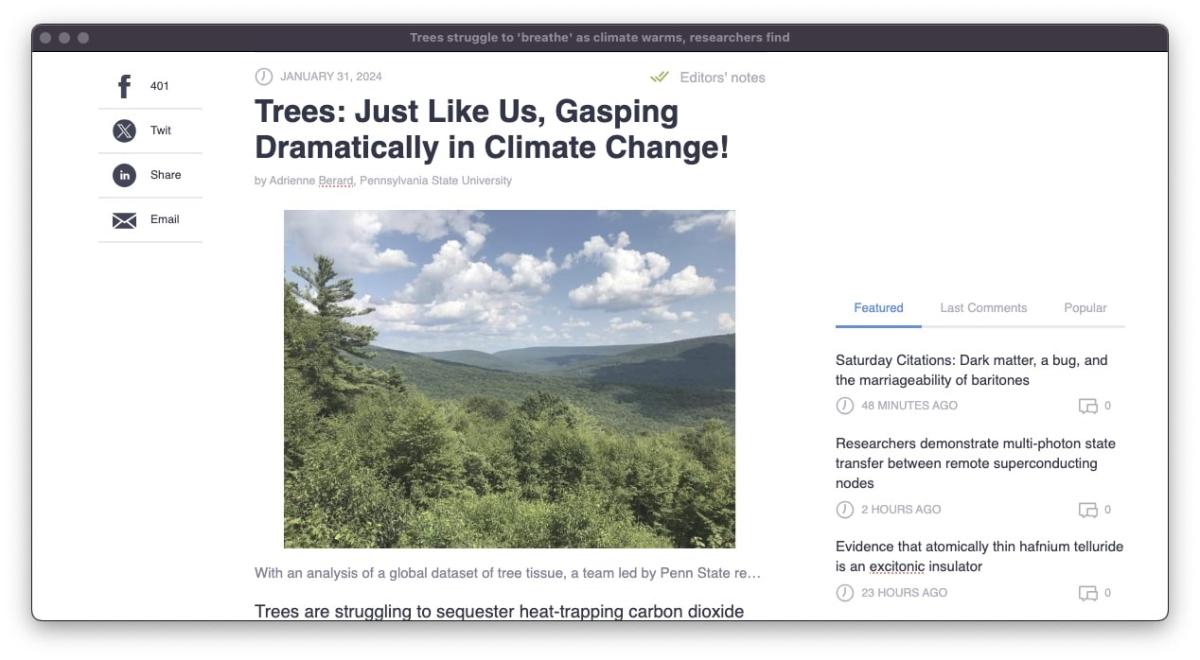Trees: Just Like Us, Gasping Dramatically In Climate Change!

Trees struggle to 'breathe' as climate warms, researchers find
Oh, trees, our supposed Climate change superheroes, are now throwing in the towel. According to Penn State researchers, in warmer, drier climates, trees are not the CO2-sucking champs we thought they were. Instead of inhaling Carbon dioxide, they're having a little coughing fit, releasing it right back into the atmosphere. Turns out, when it gets too hot and dry, trees can't be bothered to play the role of Earth's carbon cleanup crew.
Photosynthesis? That's so last season. Enter photorespiration – the tree version of exhaling loudly. This study insists that as the planet warms, trees might just be lazy and less effective at combatting our carbon mess. Great news, right? As if we needed another reason to worry about climate change. So, to sum it up, our leafy friends might be taking a break from saving the world. Thanks, trees.
A recent study led by researchers from Penn State suggests that trees may no longer be as effective in sequestering heat-trapping carbon dioxide (CO2) in warmer, drier climates, challenging their role in offsetting humanity's carbon footprint as the planet continues to warm. The study, published in Proceedings of the National Academy of Sciences, reveals that trees in such climates release CO2 back into the atmosphere through a process called photorespiration, especially when water is limited.
Photorespiration occurs when trees, under stressful conditions, release CO2 instead of removing it from the atmosphere through photosynthesis. The study analyzed a global dataset of tree tissue, demonstrating that the rate of photorespiration is up to two times higher in warmer climates, particularly when water availability is restricted. The researchers identified a threshold for this response in subtropical climates, crossing when average daytime temperatures exceed approximately 68 degrees Fahrenheit.
The findings challenge the common belief that plants, including trees, play a significant role in drawing down carbon from the atmosphere. As the climate warms, the study suggests that plants could become less efficient in removing CO2 and assimilating the necessary carbon to help cool the planet. Currently, plants absorb about 25% of the CO2 emitted by human activities each year, but this percentage is expected to decrease, especially in water-scarce environments.
The study utilized a unique approach, examining isotopes of a wood component called methoxyl groups as a tracer of photorespiration in trees. By studying wood samples from various climates and conditions worldwide, the researchers observed trends in photorespiration. The wood samples, collected in the 1930s and '40s, allowed the team to reconstruct forests' ability to take in CO2 over time.
The researchers emphasize the importance of understanding the impact of climate change on plant behavior and CO2 absorption. With the atmosphere's rapidly increasing carbon dioxide levels, surpassing any time in the last 3.6 million years, the study highlights the need to reevaluate the role of trees in mitigating climate change. The team aims to extend their research by investigating photorespiration rates in the ancient past using fossilized wood, providing insights into the changing influence of plant photorespiration on climate over geologic time. The study suggests that to comprehend our future, researchers may need to delve into the past, going back millions of years to understand how the carbon cycle operated in vastly different climatic conditions.




